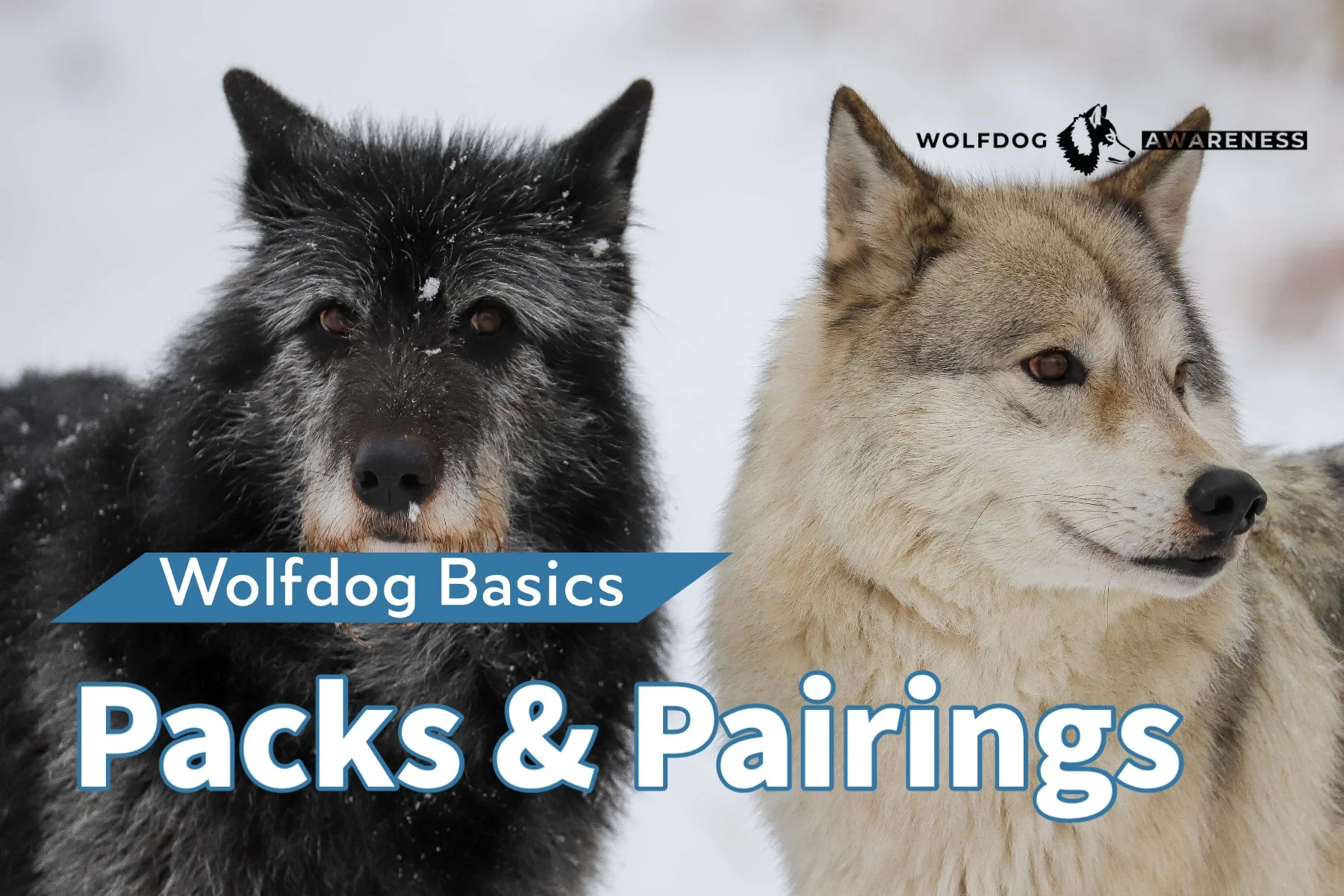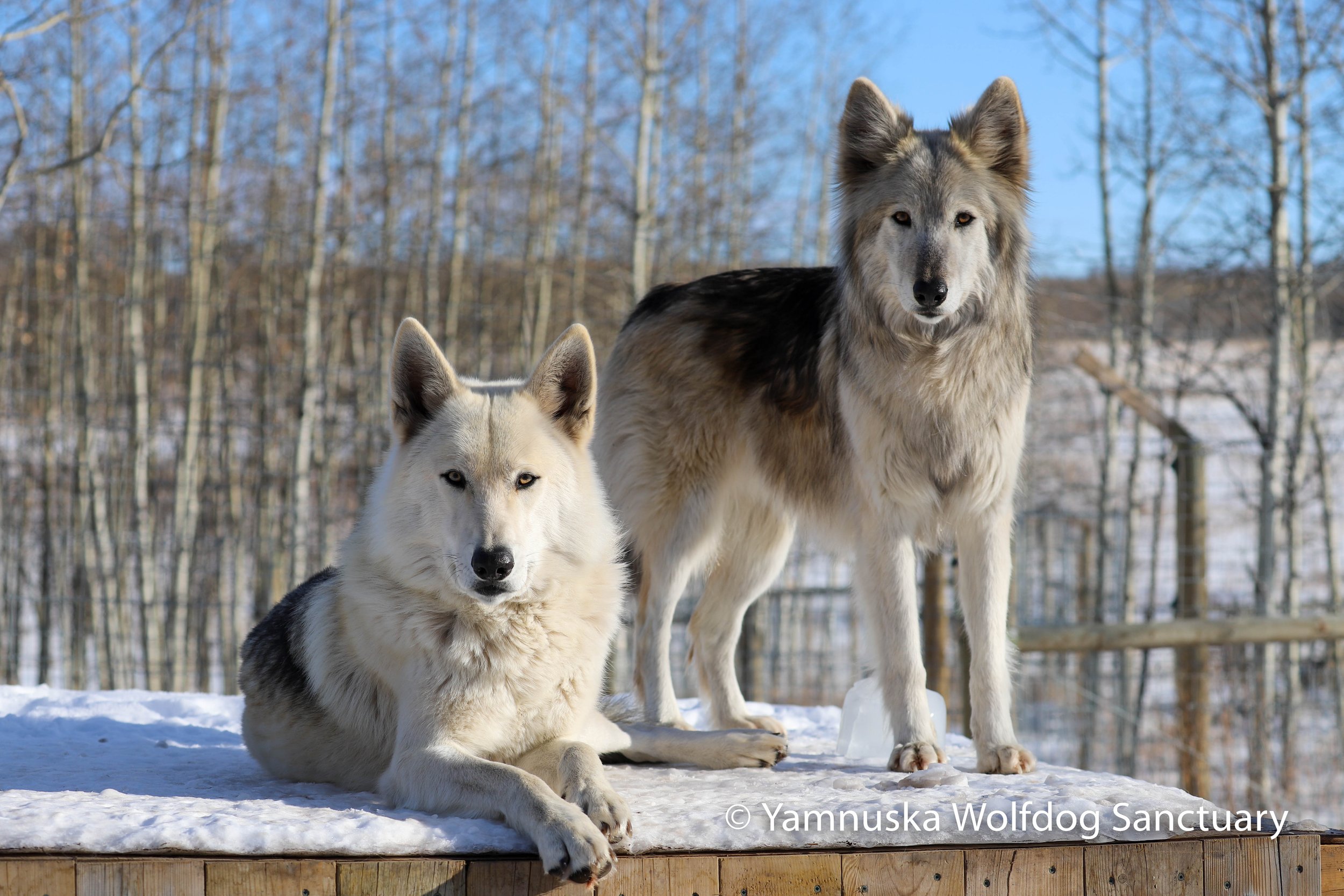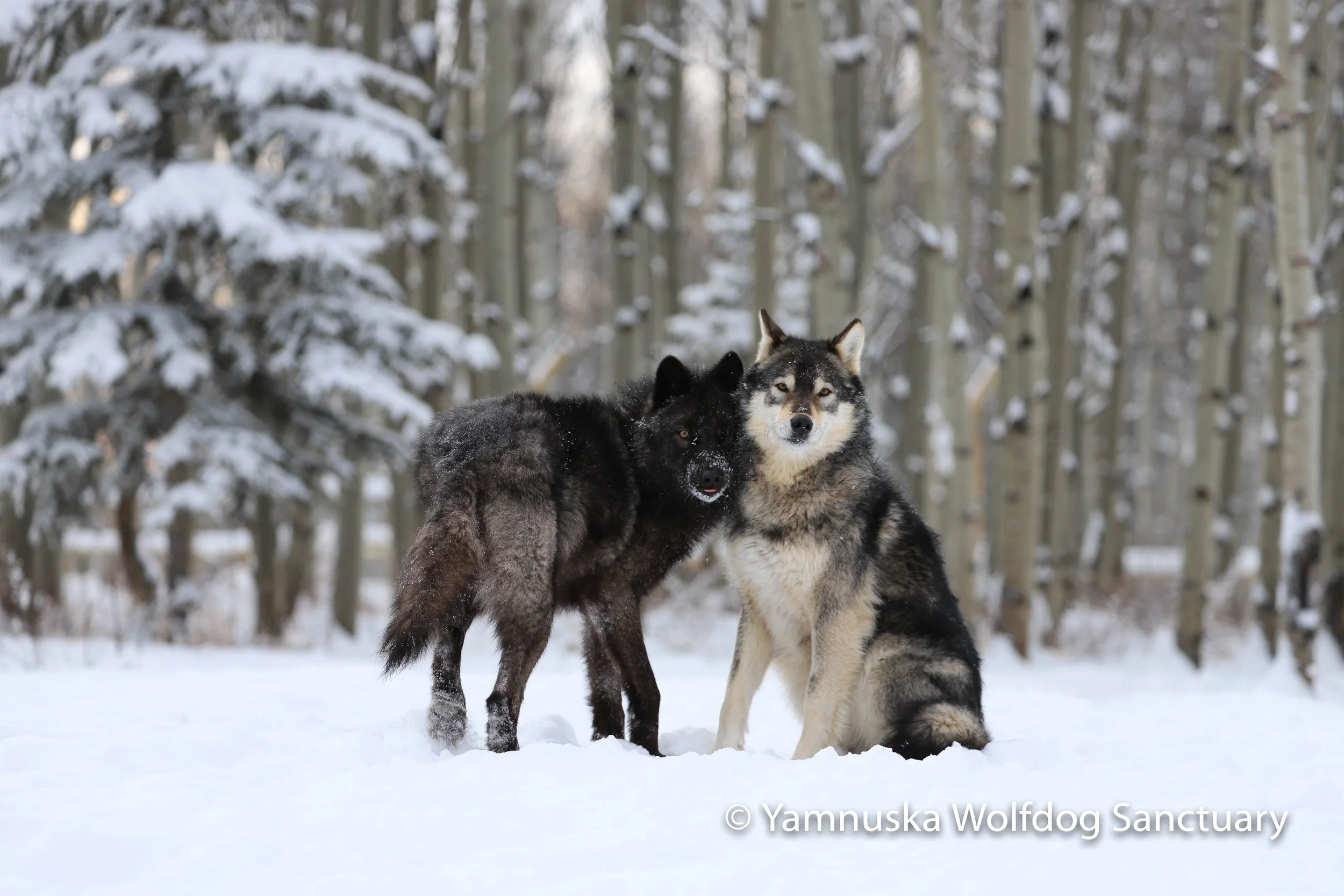Packs & Pairings
Creating pairings and packs of wolfdogs requires a lot of foresight, thought and matchmaking skills.
Like most ‘artificial’ or ‘man-made’ things, they never quite completely function like the natural thing would. When we are talking about artificially created packs, we have to realize that we can never replace the natural order of things and therefore unintended consequences will arise. In other words, by us humans creating pairings or packs of wolfdogs we have to remember we will never be able to recreate the natural order of things and therefore there will be unnatural results because of this.
Additionally, like always with wolfdogs, there can be a lot of variation from animal to animal (depending on wolf content, degree of socialization and individual predisposition), so each case is always unique.
In this article, I am going to share some of the typical experiences and challenges we face at Yamnuska Wolfdog Sanctuary when it comes to pairing wolfdogs together. Before we go into that, let’s review some of the fundamentals first.
Lichen (a high content wolfdog) with his beloved packmate Mawko (a low content wolfdog). These two are one of those odd pairings that just seems to really work. Even though they have a large discrepancy of wolf content, behaviourally and personality wise, they are a perfect match. This does not happen often!
Wolves in the wild typically live in packs that are nuclear family units; meaning it is a mom, dad and their offspring. The breeding male and female will stay together for the duration of their lives together, and each year will produce a new generation of pups. These offspring will remain with the pack for 1 to 3 years. During this time, they grow and develop into strong adolescents, learn all the skills necessary to be a successful wolf in the wild, and they help raise and care for the next generations of puppies. Once these juvenile wolves reach the age of sexual maturity, and are ready to take on the world on their own, they will willingly disperse from their pack in search of a mate and territory of their own. If successful, they will produce their own puppies and create a pack and family of their own. And so the cycle continues.
This is the natural order of things for wolves and many of their instinctual and behavioural characteristics evolved to facilitate this process.
Now let’s compare this to domestic dogs. We as humans take ownership of dogs as puppies or adults, bring them into our human family, and bring them into a home that already has or will eventually have any other dogs, cats, small animals, etc. WE manufacture the family dynamic we expect our pets to live in. Me personally for example, at the time of writing this article, I live in a household of 8 dogs. In order of most recent to least recent to join our family are a male Belgian Malinous, 3 male Irish Wolfhounds, a female Akita X, a female Rottweiler/Shepherd X, a male Pomeranian X and a female Cattle Dog X. It is a very eclectic crew to say the least. To varying degrees all these dogs get along with one another and never questioned or dictated who gets to live within our pack. Domestic dogs evolved amongst humans and in a way relinquished that responsibility to us. For dogs it is perfectly normal and acceptable to live in artificially created packs. Not only that, but since dogs have such a high degree of affinity towards humans, many dogs are even perfectly happy without a pack. Dogs receive most of their social fulfillment from us humans.
Alpha male Zeus, with his loyal companion, Nova. They have an extremely special relationship, and have lived together for over a decade.
So what about wolfdogs? Where do they land in all of this? A big part of this answer is dictated by wolf content. Where does your wolfdog lie in the wolf-to-dog spectrum?
One thing is for certain, wolfdogs live in a human world that is far removed from wild wolf pack dynamics. No matter the wolf content, we take ownership of a wolfdog as either a puppy or adult and we create an artificial pack/family setting just like we do with domestic dogs. Where the difference lies (and a large degree the challenge!) is what kind of pack dynamic will be suitable for a wolfdog.
Most low content wolfdogs will follow typical dog behaviour. Meaning they can usually live in a multi dog household without too much trouble. Of course, there are always exceptions, however if you get a low content wolfdog as a puppy, spay/neuter it, and do a good job socializing your wolfdog, there is a very good chance they can easily be integrated with other dogs no different than a typical northern breed (in other words, you might still see challenging behaviours like same sex aggression, territorial behaviour, etc.), but you’re not dealing with the complex social hierarchy that a wolf or high content wolfdog requires. In the end, your low content wolfdog will likely get a lot of social fulfillments from you the human and therefore isn’t as reliant on having a well-established pack.
High content wolfdogs are the trickiest ones. They retain a lot of wolf behaviours and therefore communicate and interact with one another very differently than dogs do. Wolves have much more specific and stricter social rules than dogs. In other words, wolves and dogs live and communicate by a different rule book. There are also a lot of behaviours they retain that make integrating them with your domestic dogs not only challenging, but also potentially risky. This poses some unique challenges when we as humans are creating 'artificial' wolfdog packs.
Father Naqqui, with his daughter, Tuvac. Tuvac has lived her whole life with her brother and father and are one of those unique packs living here at the Sanctuary that are in fact a nuclear family unit.
Given the area of work we are in, we are faced with the regular challenge of pairing wolfdogs together.
In order to do this successfully, we are always striving for 3 main things:
1. Pair wolfdogs of similar content
2. Pair opposite sexes
3. Pairing animals with complimentary behaviours
Pair wolfdogs of similar content
Pairing wolfdogs of relatively similar content helps mitigate any potential issues that could arise when it comes to communicational differences between wolves and dogs. Typically, wolfdogs of similar content will have the same types of communication and have a similar understanding of the rules of engagement with one another. Therefore, the goal is to pair high content wolfdogs with high content wolfdogs and low content wolfdogs with low content wolfdogs. With mid content wolfdogs, it can really vary. Depending on the individual’s behaviours, they may be suitable to pair with a high content, mid content or low content. In some special cases we will make exceptions and pair a high content wolfdog with a low content wolfdog for example. This requires some very special consideration and can only safely be done in certain cases. If it is a male/female pairing we can sometimes get away this without sacrificing the wellbeing of the wolfdogs. It’s in scenarios where we have packs with multiple members (3+ members in a pack) that varying wolf contents can become a risk to the safety of the individual wolfdogs.
Katahna and Seqoui are both mid content wolfdogs, and therefore share a very similar communication style and intensity level. This helps to ensure their relationship is fairly even and well matched.
Pair a male with a female
This is especially important with mid to high content wolfdogs. Since wolfdogs can be prone to same sex aggression, the safest and most reliable pairings are male/female relationships. This makes sense as wolf packs typically have a dominant male and dominant female that work together to run a pack. With a male/female pairing, each individual is able to establish themselves as the dominant male/female of the pack. By playing into this instinctual behaviour, this vastly mitigates the risk of any major conflicts happening that could result in any significant injuries. That being said, the next point must also be taken into account.
Odin and Freya share a mutual love for one another.
Pairing animals with complimentary behaviours
Just like with humans, it's important to take individual personalities and mannerisms into account. For example, putting two very stubborn and dominant personalities together will likely lead to a lot of conflict and bickering within the relationship. Whereas if we can pair a more stubborn animal with perhaps another that is patient and giving, this will drastically increase the likelihood of a harmonious relationship.
Nova is extremely submissive and respectful of his alpha male, Zeus. Nova is happy to follow Zeus’s lead and is perfectly happy not to worry about being the dominant member of the pack responsible for making decisions. Nova’s role is support his alpha male and female and protect the pack from any potential threat or harm.
Here at the Sanctuary, we have had good success housing low content wolfdogs with multiple other low content wolfdogs or even domestic dogs. Pack dynamics end up being pretty similar to that of domestic dogs and therefore there is usually little risk or issues that arise. That being said, this does not mean that issues can’t arise. I have come across multiple low content wolfdogs that are same sex aggressive and are not very tolerant of other dogs. But *most* low content wolfdogs tend to behave similar to domestic dogs as far as their relations and interactions to other dogs and wolfdogs.
When it comes to our high content wolfdogs, the vast majority live in male-female pairings that have personalities that complement one another. In almost all of these pairings, there is no safe way with no ability to add any additional adult members to the pack. Again, if we think about wolf behaviour this makes sense. New members are born into a pack. Any adult wolves that come in the vicinity of an establish pack is seen as a threat to that pack. Wolves are naturally extremely territorial and untrusting of new individuals. It is safer to chase off any strange outside wolves, than risk the safety and wellbeing of the pack.
We do have a few exceptions where we have packs of 3 to 4 animals. In all of these cases, the wolfdogs have either all grown up together as puppies, or the submissive members were introduced as puppies. We have only ever been successful at integrating an adult wolfdog into an established pack of high content wolfdogs, but this pack is particularly exceptional.
The Engadine and Temple packs are both packs of 3 sibling high content wolfdogs that have grown up together as littermates. They were able to establish a dominance hierarchy that works amongst them. The Fortress and Castle Packs are packs of mid and high content wolfdogs where the additional members of the pack were born to the dominant pair (just a note here, they were rescued as adult packs; we did not keep intact animals together and allow them to breed!). In both of these cases, these packs seem to just work because they somewhat follow the natural order of things where the pups were born into the pack. They have also all been spayed and neutered to help mitigate any pressures based around mating. That being said, there are conflicts within the pack that have to be managed at times to ensure the safety and wellbeing of everyone.
The Yamnuska Pack is comprised of 3 high content wolfdogs and 1 low content wolfdog.
My last case study I want to share is our Yamnuska Pack. It is currently a pack of 4 wolfdogs that have been together for over a decade. Over the years this pack has added and lost members. The original pairing was a male and female wolfdog, Kuna and Zeus. They were brought up around other dogs and were exceptionally social. Prior to their sexual maturity, I was able to integrate a high content male puppy (Nova), a mid content female puppy (Kaya) and an adolescent low content female (Nikki). To this day, the 3 high contents and 1 low content wolfdog are still living together as a pack. Within this time frame, we were able to integrate additional puppy wolfdogs within this pack, however, time and time again when these pups reached sexual maturity, they created conflict to the point where we had to make the decision to pull these youngster out of the pack and pair them with their own mate. In other words, these adolescent wolfdogs were dispersed from their pack. For whatever reason, Kuna, Zeus, Nova and Nikki have always remained a tight knit pack.
If you’re interested in learning about the actual process we go through to pair wolfdogs together and what all those steps entail, email me and let me know. If this is information that is valuable to you, I am happy to create an article outlining exactly how we do it and what things we look for that indicate whether this pack will ultimately be successful or not.
Summary:
Creating pairings and packs of wolfdogs requires a lot of foresight, thought and matchmaking skills
When we create artificial packs, we can never replace the natural order of things and therefore unintended consequences will arise
Wolves and dogs live and communicate by a different rule book
Wolves in the wild typically live in packs that are nuclear family units; meaning it is a mom, dad and offsprings
For dogs it is perfectly normal and acceptable to live in artificially created packs
Most low content wolfdogs will follow typical dog behaviour
Whenever creating a pack or pairing of wolfdogs we are always striving for 3 main things: Pair wolfdogs of similar content, pair opposite sexes, pairing animals with complimentary behaviours
Pairing wolfdogs of relatively similar content helps mitigate any potential issues that could arise when it comes to communicational differences between wolves and dogs
Wolfdogs can be prone to same sex aggression, therefore, the safest and most reliable pairings are male/female relationships
It's important to take individual personalities and mannerisms into account and try to match complementary personalities together








